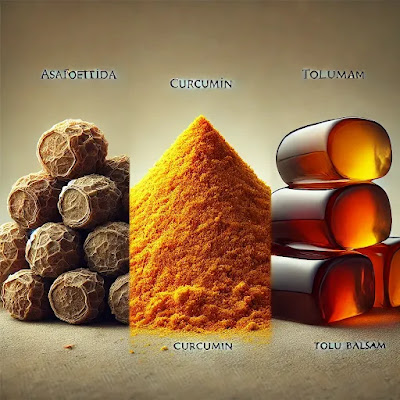1. Asafoetida Identification Test
- Organoleptic Test: Asafoetida has a strong, pungent odor, which is very distinctive. The resin is usually yellowish-brown.
- Color Reaction Test:
- Dissolve a small amount of asafoetida in ethanol and add a few drops of concentrated sulfuric acid. The solution turns violet to red.
- Microscopic Examination: A powdered sample may be observed under a microscope, where fragments of resin ducts and irregular particles can help in identification.
2. Curcumin Identification Test (Curcumin is the active compound in turmeric)
- Borax Test:
- Dissolve curcumin in ethanol and add borax solution. A red color develops, indicating the presence of curcumin.
- Concentrated Sulfuric Acid Test:
- When curcumin is mixed with concentrated sulfuric acid, it gives a deep reddish-brown color.
- UV Fluorescence Test:
- Curcumin exhibits bright yellow fluorescence under UV light, which helps in confirming its identity.
3. Tolu Balsam Identification Test
- Solubility Test:
- Tolu balsam is soluble in ethanol, benzene, and chloroform, but only partially soluble in water. A fragrant odor characteristic of balsams can be noticed.
- Fehling's Solution Test:
- When heated with Fehling's solution, tolu balsam gives a reddish precipitate, indicating the presence of reducing sugars.
- Vanillin-HCl Test:
- Dissolve a small quantity of tolu balsam in alcohol and add vanillin reagent. A pink to red color appears, which is characteristic of the presence of cinnamic and benzoic acids.
These tests help in identifying the specific substances by observing their distinct physical or chemical reactions.







0 Comments
Thanks for your feedback, i'll get back to you soon.